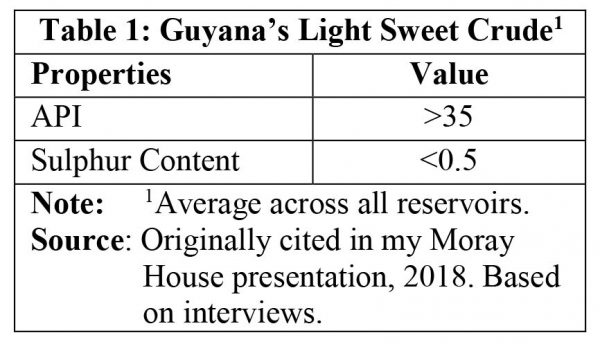Today’s column presents my justification for the “bullish estimate of 13 to 15 billion barrels of high quality oil as Guyana’s reserves potential.” Based on this estimated potential, I have gone further to predict Guyana’s daily rate of production (DROP) at full ramp-up (or operating at maximum/peak output) is likely to be as high as 1.5 to 2.5 million barrels of high quality crude oil per day.
These estimates are central to projecting Guyana’s expected petroleum revenues. The indirect method I employed to estimate Guyana’s DROP was indicated last week.
I mention “high quality crude oil” because of indications that, on average across all reservoirs, Guyana’s crude is “light sweet.” The referenced supporting statistics are an API >35 and low sulphur content — less than 0.5. These data are shown in Table 1.
As also indicated last week, my justification for a “bullish outlook” follows four principal lines of argumentation. These are, in the order in which they are discussed: 1) Guyana’s petroleum geology; 2) US geological assessments; 3) supporting indications from established petroleum research and analysis firms and authorities; and 4) indicators from Guyana’s “creaming curve.” Items 1 and 2 are covered in today’s column.
Justification 1: Petroleum Geology
First, a bit of background would be useful. So far Guyana’s recent petroleum discoveries are located in the Stabroek Block; one of three major blocks that ExxonMobil has contracted for with the Government of Guyana (GoG). The other two are the Kaieteur and Canje Blocks. The Stabroek Block is an area of 6.6 million acres or 26,800 square kilometers offshore the Guyana Coastline. This is where the leading oil and gas exploration is presently taking place, under a Production Sharing Agreement (PSA) between the GoG and ExxonMobil and partners.
ExxonMobil’s first discovery was announced in May, 2015. This followed the successful drilling of the Liza-1 well. The well was drilled to 17,825 feet in 5,719 feet of water, and is located 120 miles off the Guyana Coast. It encountered 295 feet of oil bearing sandstone reservoirs. The initial estimation is for 700 million barrels of commercially recoverable oil. Subsequent to this, other wells were successful and these were later announced by ExxonMobil.
The basic background is that geoscientists have posited this occurrence is the outcome of the earlier drifting apart of what was originally, a unified super-continent, combining both South America and Africa. This took place over geological time, millions of years ago. The geologic principle is that the Guianas Equatorial Margin encompasses both offshore and onshore portions of Guyana, Suriname, French Guiana, as well as limited portions of Venezuela and Brazil. The petroleum geology of the Guianas area closely resembles that of West Africa. Indeed, the Guianas Equatorial Margin includes two sedimentary basins, namely, the Guyana-Suriname Basin and the Foz do Amazonas Basin.
In my earlier columns on this topic, I had cited Justin Stolte, who noted in his paper “Testing the Atlantic Mirror Theory” that geologists view “the petroleum system of the Guianas Basin as a mirror image – labelled the ‘Atlantic Mirror’ theory – of the petroleum system present in West Africa.” As I had observed in those earlier columns, he goes further to suggest that “the similarities of such basins” are responsible for the rush by multiple companies exploring for gas and oil offshore and onshore Guyana! Indeed, during the late 2000s and 2010s, several companies had engaged in systematic petroleum explorations, including Repsol, Century Guyana Ltd, CGX Energy, Anadarko, RATIO Oil, Eco Atlantic, Tullow, NABI Oil and ExxonMobil.
It is also reported that the Guianas Equatorial Margin, embraces two sedimentary basins (known collectively as the “Guianas Basins”). These are separated by the Demerara Plateau, which is a structurally high, thick succession of Jurassic and Lower Cretaceous carbonate-rich sediments.
This yields the thesis that, the petroleum system of the Guianas Basin is a mirror-image – labeled the “Atlantic Mirror” theory – of the petroleum system present in West Africa, where several large petroleum accumulations have been discovered in recent years, including, the Jubilee discovery offshore Ghana.
Justification 2: USGS Assessment
My second line of argumentation is based on support found in two United States Geological Surveys, World Energy Assessment of Undiscovered Oil and Gas Resources in Central and South America as well as the Caribbean (2000 and 2012). These treated our region as a subset of the World Assessment. The assessment covered the volume of undiscovered conventional petroleum reserves.
The information for this subset indicates that it is: 1) “fully risked” reserves; 2) estimates are provided at levels of 95, 50, and 5% probability (additionally, the mean probability is reported where fractiles are additive, under the assumption of perfect positive correlation); and 3) estimates for gas fields include all liquids. Undiscovered gas resources are therefore the sum of non-associated and associated gas. Both Survey results are shown in Table 2.
For the 2000 assessment, estimates range from at least 2.8 billion barrels of oil at 95 percent likelihood to at least 32.6 billion barrels at 5% likelihood. The 50% likelihood is at least 13.9 billion barrels of oil equivalent and the mean is at least 15.2 billion barrels of oil equivalent. For the 2012 assessment, estimates range from at least 5.2 billion barrels at 95% and 26.0 barrels at 5%. The 50% likelihood is 12.5 billion barrels and the mean is 13.6 billion barrels. Current discoveries reveal amounts larger than the 95 percent likelihood estimate for both assessment.
Two observations are warranted. First, these estimates are for a virgin frontier region and therefore remain reliant on petroleum geology assessment. Second, the mean natural gas estimates are for 42.1 and 21.2 billion cubic feet, respectively.
Conclusion
Next week I report on the two other justifications for my “bullish outlook,” This would then complete discussion of Guidepost 2 in the Road Map dimension “getting oil and gas revenues.”









